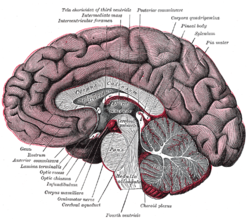Corpus callosum
The corpus callosum is part of the brain in humans and other eutherian mammals. It is the largest connective pathway in the brain. Its over 200 million nerve fibers connect the left and right hemispheres of the brain.
| Corpus callosum | |
|---|---|
 Corpus callosum from above. (Anterior portion is at the top of the image.) | |
 Median sagittal section of brain (person faces to the left). Corpus callosum visible at center, in light gray | |
| Details | |
| Part of | Human brain |
| Parts | Genu, trunk, splenium |
| Identifiers | |
| MeSH | D003337 |
| NeuroNames | 191 |
| NeuroLex ID | birnlex_1087 |
| TA | A14.1.09.241 |
| FMA | 86464 |
| Anatomical terms of neuroanatomy | |
The corpus callosum relates to the lateralization of brain function. Because the two side of the brain communicate so intensively, they can afford to specialise in doing somewhat different things.[1]
Only in higher mammals
changeThe corpus callosum is found only in placental mammals (the eutherians). It is absent in monotremes and marsupials,[2] and other vertebrates such as birds, reptiles, amphibians and fish.[3]
Other groups do have brain structures that allow for communication between the two hemispheres. The anterior commissure serves as the main cross-hemisphere communication in marsupials.[4][5][6]
The fibrous bundle of the corpus callosum increases to such an extent in humans that it wedges apart the hippocampal structures.[7]
References
change- ↑ Caminiti, Roberto et al 2009. Evolution amplified processing with temporally dispersed slow neuronal connectivity in primates. Proceedings of the National Academy of Sciences 106 (46): 19551–6. [1]
- ↑ Keeler, Clyde E. (1933). "Absence of the corpus callosum as a mendelizing character in the house mouse". Proceedings of the National Academy of Sciences of the United States of America. 19 (6): 609–11. Bibcode:1933PNAS...19..609K. doi:10.1073/pnas.19.6.609. JSTOR 86284. PMC 1086100. PMID 16587795.
- ↑ Sarnat, Harvey B. and Paolo Curatolo 2007. Malformations of the nervous system in Handbook of Clinical Neurology, p. 68[permanent dead link]
- ↑ Ashwell, Ken 2010. The neurobiology of Australian marsupials: brain evolution in the other mammalian radiation. p. 50
- ↑ Armati, Patricia J., Chris R. Dickman, and Ian D. Hume 2006. Marsupials, p. 175
- ↑ Butler, Ann B. & William Hodos 2005. Comparative vertebrate neuroanatomy: evolution and adaptation. p. 361
- ↑ Morris H. & Schaeffer J.P. 1953. The nervous system: the brain or encephalon. In Human anatomy; a complete systematic treatise. 11th ed, New York: Blakiston. pp. 920–921, 964–965).